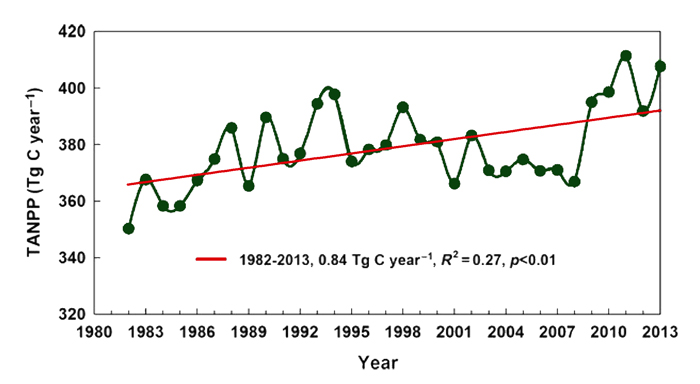| Follow @co2science |
Paper Reviewed
Jiao, C., Yu, G., Ge, J., Chen, X., Zhang, C., He, N., Chen, Z. and Hu, Z. 2017. Analysis of spatial and temporal patterns of aboveground net primary productivity in the Eurasian steppe region from 1982 to 2013. Ecology and Evolution 7: 5149-5162.
Introducing their intriguing new study, Jiao et al. (2017) write that "aboveground net primary productivity (ANPP) represents the major input of nutrition and energy into ecosystems, and it is an integral indicator of ecosystem functioning." It is also a key component of the terrestrial carbon cycle and can "indicate the growth status of vegetation, for which variations over time reflect the response of ecosystems to climate change." However, they note that estimates of ANPP are still lacking for the Eurasian steppe region -- a large grassland region that spans an area from 28-53°N latitude and 36-125°E longitude. Thus, in an effort to help fill this data void, the team of eight Chinese scientists set out to compile and analyze an ANPP database for the Eurasian steppe for the period 1982 to 2013.
To accomplish their purpose, Jiao et al. utilized field observations from a total of 1539 sites, which they combined with long-term normalized difference vegetation index (NDVI) remotely-sensed data within a model framework, to estimate annual ANPP for the Eurasian steppe. The resulting time series of ANPP for the entire region is presented in Figure 1 below. As seen there, ANPP values "showed an obvious increase from 1982 to 2013, "in the words of Jiao et al., rising by 0.84 Tg C (0.49%) per year, amounting to a 16% increase over the 32-year period.
With respect to the cause of the increase, this was not the focus of the authors' study. However, we note that the results of several other recent studies suggest atmospheric CO2 enrichment is likely playing a key role (see, for example, the studies of Zhu et al., 2016, Li et al., 2017 and Cheng et al., 2017). Yet regardless of the cause(s) driving this increase, we can all appreciate the fact that the productivity of the Eurasian steppe has risen over the past three decades despite natural and anthropogenic pressures to the contrary. And that is good news worth reporting!

Figure 1. Total aboveground net primary productivity (TANPP) for the Eurasian steppe over the period 1982 to 2013. Adapted from Jiao et al. (2017).
References
Cheng, L., Zhang, L., Wang, Y.-P., Canadell, J.G., Chiew, F.H.S., Beringer, J., Li, L., Miralles, D.G., Piao, S. and Zhang, Y. 2017. Recent increases in terrestrial carbon uptake at little cost to the water cycle. Nature Communications 8: 110, DOI:10.1038/s41467-017-00114-5.
Li, P., Peng, C., Wang, M., Li, W., Zhao, P., Wang, K., Yang, Y. and Zhu, Q. 2017. Quantification of the response of global terrestrial net primary production to multifactor global change. Ecological Indicators 76: 245-255.
Zhu, Z., Piao, S., Myneni, R.B., Huang, M., Zeng, Z., Canadell, J.G., Ciais, P., Sitch, S., Friedlingstein, P., Arneth, A., Cao, C., Cheng, L., Kato, E., Koven, C., Li, Y., Lian, X., Liu, Y., Liu, R., Mao, J., Pan, Y., Peng, S., Penuelas, J., Poulter, B., Pugh, T.A.M., Stocker, B.D., Viovy, N., Wang, X., Wang, Y., Xiao, Z., Yang, H., Zaehle, S. and Zeng, N. 2016. Greening of the Earth and its drivers. Nature Climate Change DOI: 10.1038/NCLIMATE3004.
Posted 29 December 2017



